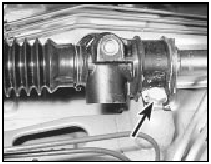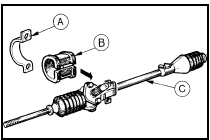Steering gear - removal, overhaul and refitting
Removal
Note: New tie-rod balljoint split-pins must be
used on refitting.
1 Set the front roadwheels in the straightahead position.
2 Raise the front of the vehicle and fit stands (see “Jacking and Vehicle Support”). Remove the front roadwheels.
3 Working under the bonnet, remove the pinch-bolt from the coupling at the base of the steering column shaft.
4 Extract the split pins from the tie-rod balljoint taper pin nuts, unscrew the nuts and remove them.
5 Separate the balljoints from the steering arms using a suitable separator tool.
6 Flatten the locktabs on the steering gear securing bolts and unscrew and remove the bolts. Withdraw the steering gear downwards to separate the coupling from the steering shaft and then take it out from under the front wing (see illustrations).

26.6a Steering gear-to-bulkhead mounting retaining bolt and locktab (arrowed)

26.6b Steering gear mounting details
A Clamp
B Bush
C Steering gear
Overhaul 7 Examine the steering gear assembly for signs of wear or damage, and check that the rack moves freely throughout the full length of its travel, with no signs of roughness or excessive free play between the steering gear pinion and rack. It is possible to overhaul the steering gear assembly housing components, but this task should be entrusted to a Ford dealer. It is likely to be cheaper to obtain an exchange reconditioned steering gear assembly (which will be supplied complete with tie-rods) than to overhaul a worn or damaged assembly. The only components which can be renewed easily by the home mechanic are the steering gear bellows, and the tie-rod outer balljoints. Renewal procedures for the bellows and tie-rod outer balljoints are given in Sections 20 and 21 respectively.
Refitting
8 If a new steering gear assembly is being
installed, the tie-rods balljoints may have to
be removed from the original unit and
screwed onto the new tie-rods to
approximately the same setting. If a note was
not made of the position of the original tie-rod
balljoints on their rods, inspection of the
threads will probably indicate their original
location. In any event it is important that the
new balljoints are screwed on an equal
amount at this stage.
9 Make sure that the steering gear is centred.
Do this by turning the pinion shaft to full lock in one direction and then count the number of turns required to rotate it to the opposite lock.
Now turn the splined pinion shaft through half the number of turns just counted.
10 Check that the roadwheels and the steering wheel are in the straight-ahead attitude, offer up the steering gear and connect the shaft coupling without inserting the pinch-bolt.
11 Bolt up the gear housing and lock the bolts with their lockplate tabs.
12 Reconnect the tie-rod balljoints to the steering arms. Tighten the securing nuts to the specified torque setting and fit new split pins to secure.
13 Tighten the coupling pinch-bolt to the specified torque. Refit the roadwheels and lower the vehicle to the floor.
14 If the tie-rods were disturbed or if a new assembly was installed, check and adjust the wheel alignment, as described in Section 27.
See also:
Fuel pump - testing
1 If the fuel pump is functioning, it should be
possible to hear it “buzzing” by listening
under the rear of the vehicle when the ignition
is switched on. Unless the engine is started,
the fuel pu ...
Rear suspension angles - general
The rear wheel toe and camber angles are
set in production and do not require checking
under normal service conditions. Of the two,
only the toe setting can be adjusted, the
camber angle being fix ...
Rear suspension/final drive unit rear mounting (Saloon, Hatchback and Estate
models) - renewal
Note: From May 1986, revised rear
suspension/final drive unit rear mounting bolts
have been used in production. Whenever the
earlier type of bolts are removed, they should
be discarded and the lat ...
